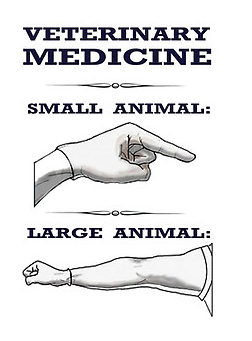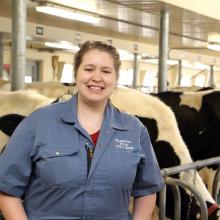Ahh palpation. Sometimes your hands can be your most valuable diagnostic tool! While small animal vets do rectal palpation (with one finger) to feel for things like anal glands and the prostate gland, the palpation I’m talking about today is rectal palpation in large animals. It truly is one of the most valuable skills to master when working with cows, and one that I’ve been working hard at during my externship.
 Our herd health visits are spent mostly with our arms in the business end of a cow, feeling for pregnancies, detecting where the cow is in their estrus cycle to figure out when to breed them, and checking for any uterine conditions (like what I wrote about in my 4th bog post!). But it’s not just for reproductive purposes! In sick cows, you can feel for the kidneys and the caudal aorta for any abnormalities, and judge the fullness of the rumen (a nice, full rumen indicates the cow is eating well, but a gas distended rumen indicates bloating). You can feel if other intestinal organs are bloated, you can feel for any abnormal masses, and you can feel for normal uterine involution (or shrinking) after calving. Rectal palpation is such a vital part of a physical exam, and don’t worry, it doesn’t bother the cows!
Our herd health visits are spent mostly with our arms in the business end of a cow, feeling for pregnancies, detecting where the cow is in their estrus cycle to figure out when to breed them, and checking for any uterine conditions (like what I wrote about in my 4th bog post!). But it’s not just for reproductive purposes! In sick cows, you can feel for the kidneys and the caudal aorta for any abnormalities, and judge the fullness of the rumen (a nice, full rumen indicates the cow is eating well, but a gas distended rumen indicates bloating). You can feel if other intestinal organs are bloated, you can feel for any abnormal masses, and you can feel for normal uterine involution (or shrinking) after calving. Rectal palpation is such a vital part of a physical exam, and don’t worry, it doesn’t bother the cows!
Understandably, I wanted to be quick to master this important skill. We learn to do rectal palpation in second year, but we get little practice in school after that. For my very first herd visit I gloved up, lubed up, and eagerly dove in. I expected to know what I was feeling, instead it was just a black hole. The goal of reproductive rectal palpation is to clean out any feces, feel for the reproductive tract, retract the uterus so we can feel it more completely, and to sweep up and feel the ovaries for any structures like a follicle, a corpus luteum, or a cyst. Instead of being able to do all of this, I just felt indistinct structures, lots of feces, and a tired arm. The vet assured me that it is a skill that comes with lots and lots of repetition, but I still felt discouraged. For the first week I felt like this, but I still made myself persist. To be honest, I started to dread herd health for the sole reason of not wanting to feel incompetent. How did these vets make it look so easy?
 Slowly, I started becoming familiar with what I was feeling. I could feel the uterus, and sweep around to find some ovaries. I was quite slow, but I was starting to get it. In my second week, I finally retracted a uterus successfully, and could feel all the important structures in their entirety. This took a lot of patience, and palpating probably over 50 cows. My arm was also building stamina too!
Slowly, I started becoming familiar with what I was feeling. I could feel the uterus, and sweep around to find some ovaries. I was quite slow, but I was starting to get it. In my second week, I finally retracted a uterus successfully, and could feel all the important structures in their entirety. This took a lot of patience, and palpating probably over 50 cows. My arm was also building stamina too!
Next was trying to feel what was going on with the ovaries. By my 3rd week, I was starting to be put on the spot. The vets would feel the ovaries first, and then get me to tell them what I felt after I was done. I was probably wrong about 50 per cent of the time, but slowly the accuracy increased.
Up until my fourth or fifth week, I was only palpating “open” cows, or non-pregnant cows. But with lots of repetition, my palpation got better, and it was time to work on pregnant cows. The vet would palpate and confirm a pregnancy of a certain length (we started with about 70 days and worked our way down), and then I would go in and see what it felt like. Again, I felt like I was starting from ground zero, and I couldn’t be reliably confident in pregnant versus non-pregnant. For the second time, I was faced with having to get some repetition in before I could improve.
Patience and persistence is key! By my sixth week, I could diagnose a 60-day pregnancy, which was confirmed by the veterinarian. Just when I thought I was doing well, I decided to add another level of difficulty, at the urging of the large animal vets. It was time to learn to use an ultrasound.
.jpg) Thanks to the student loaner program through BCF Technology, I got a reproductive ultrasound of my very own for the last two weeks of my externship. It was very spiffy, with a pair of goggles with little screens on them so you can see your image right in front of your eyes. It was sleek and intimidating. Just as I expected, it was difficult to get the hang of. How do you hold this probe in your hand and scan the uterus and ovaries properly? I should have known the answer: REPETITION. I used my ultrasound on every cow I could, trying to take advantage of the short time I had with this awesome tool. Finally, during my eighth week, I was able to help out the vets and do my own pregnancy checks down to about 40 days in length, and confirm with my ultrasound, which cut down on the length of time for our herd visits!
Thanks to the student loaner program through BCF Technology, I got a reproductive ultrasound of my very own for the last two weeks of my externship. It was very spiffy, with a pair of goggles with little screens on them so you can see your image right in front of your eyes. It was sleek and intimidating. Just as I expected, it was difficult to get the hang of. How do you hold this probe in your hand and scan the uterus and ovaries properly? I should have known the answer: REPETITION. I used my ultrasound on every cow I could, trying to take advantage of the short time I had with this awesome tool. Finally, during my eighth week, I was able to help out the vets and do my own pregnancy checks down to about 40 days in length, and confirm with my ultrasound, which cut down on the length of time for our herd visits!
I still have lots of practice to do, but I’m thrilled with the progress I’ve seen in my 8 weeks. Thanks so much to the large animal vets, especially Dr. Brownridge, for pushing me to keep going and encouraging me to make progress. And of course, thank you to the farmers for giving me the chance to practice on their cows. There were several farms I went to multiple times, and it was great getting to know these farmers and their herds. The moral of the story; patience, persistence and repetition are so important for developing this skill or any other skill!
